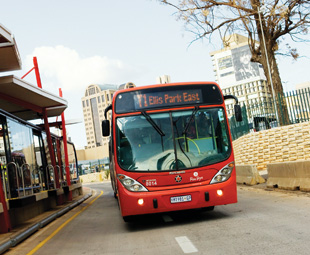Getting to the grind

Public transport systems are fundamental for sustaining economies and promoting further growth, but how successful can they be when they’re used primarily – and often grudgingly – by those who have no other choice? What makes clean, comfortable, reliable, fast, secure, safe and affordable transport services so difficult to achieve? JACO DE KLERK reports.
South Africa has the densest road network of any country in Africa, spanning around 754 000 km, with paved or surfaced roads accounting for some 70 000 km. The country has a national road network of 16 750 km. Despite this, road congestion remains a problem in the major cities of South Africa.
In developed countries, this problem is addressed, and partly alleviated, by public transport systems. However, there is a global perception that South Africa’s public transport services lack safety and reliability. An example of this can be found on the website Travel.State.Gov, a service of the bureau of consular affairs of the United States Department of State. It warns American citizens that: “Often, the safety standards on public transportation systems in South Africa are not on par with what travellers would expect in the United States. We recommend you use individual metered taxis from established taxi companies and tour buses wherever possible.”
Fuelling this perception – or reality – are the peculiarities characterising public transport in developing countries such as South Africa that are generally absent when compared to the transport systems in developed countries.
In his research article “Overview of public transport policy development in South Africa”, Professor Jackie Walters, head of the Department of Transport and Supply Chain Management at the University of Johannesburg, states that the chief abnormality is the abundance of low-capacity 16-seater vehicles (minibus taxis) within the commuter services and the dominance of this transport form in the public transport sphere. He adds that minibus taxis are responsible for around 65 percent of the estimated 2,5 billion annual passenger trips in urban areas, as well as a high percentage of rural and intercity transport. Buses service around 21 percent of the population, with trains accounting for the rest. However, the taxi industry is associated with issues such as a lack of vehicle maintenance, inter-association rivalry, some challenges of sustainability and a dated fleet age profile, which further harms perceptions about South African public transport systems.
In 2003, a National Household Travel Survey, the first of its kind in South Africa, was conducted among 50 000 households. It revealed that South Africans also doubt the country’s public transport systems. Almost half of the households surveyed said the systems are either not available or situated too far away, creating some problems for commuters. One third stated that a lack of safety and bad driver behaviour was public transport’s greatest dilemma, and 20 percent said the cost of public transport was too high.
Walters says the survey indicated high rates of dissatisfaction in several areas – with 74 percent of respondents unhappy about bus stop facilities, 54 percent unhappy about crowding on buses, and 51 percent dissatisfied with low availability of off-peak services. The biggest frustration related to inadequate safety, with 67 percent of minibus taxi users expressing concerns; of these, 64 percent criticised the lack of facilities at taxi ranks and 60 percent were worried about the roadworthiness of the vehicles.
The problems facing our country’s public transport industry aren’t new, and the topic is ever-present in government discussions. Paramount problems include the need for citizens to walk long distances to reach pick-up points, extended waiting times for services, inadequate coverage on uneconomical routes, and poorly arranged schedules. The industry is also plagued by low operating speeds resulting from traffic congestion along major corridors.
Despite this, the situation isn’t all doom and gloom. Government is taking steps to address the problems. The Public Transport Strategy for 2007 to 2020 aims to improve public transport by establishing Integrated Rapid Public Transport Networks. The strategy includes rail, taxi and bus services, and has led to the Gautrain as well as the Bus Rapid Transit (BRT) systems in Johannesburg and Cape Town. The long-term goal is to have 85 percent of these cities’ populations within one kilometre of a network that provides clean, comfortable, reliable, fast, secure, safe and affordable transport services.
Johannesburg’s BRT system – Rea Vaya (Sotho for “We are going”) – opened in August 2009, and transported 35 000 commuters in its first year. Cape Town’s MyCiti system’s first full phase commenced in May 2011 and has bike lanes running parallel to the BRT corridors. This creates greater scope for citizens to commute within the Mother City.
But these systems aren’t the ultimate answer to South Africa’s public transport problems. The current initiatives do fall short of expectations. The first can be seen in the economic hub of South Africa, where the Gautrain and Rea Vaya routes merely reinforce the current public transport routes and corridor services. Commuters are still faced with the challenge of reaching a pick-up point. In some cases, they have to use two different forms of public transport before they can utilise these networks, which kind of defeats the purpose.
Another problem is that these initiatives run parallel – and have adopted what were traditionally viewed as minibus taxi routes, creating unhealthy competition in the overall public transport sphere. Taxi associations and commuters continue to argue that the Rea Vaya routes could have been implemented to rather service the outlying and under-serviced routes as a way of improving transport services. This would have provided a solution for commuters in rural areas who rely on public transport to get to and from work, rather than just servicing the inner-city routes that taxis already provide for.
To combat this, government suggested that the existing public transport industry should be formalised and involved in the BRT initiatives as a possible solution to the rivalry problem. This proposal has been welcomed by some taxi operators but opposed by many, resulting in violent outbursts by taxi drivers against fellow associations and other public transport operators alike.
One example of this occurred in February this year. Taxi commuters had to run for cover when unknown men opened fire on a driver during a drive-by shooting. It is suspected that the shooters were from a rival taxi service operation.
So even though South Africa’s public transport systems are fundamental for sustaining the economy and a vital tool for further growth, they need some intense work from government and operators alike to ensure the safety, security and convenience of all commuters using these much-needed services.
Published by
Focus on Transport
focusmagsa




 !
From 1 Apri
!
From 1 Apri

 Big news from FOCUS on Transport + Logist
Big news from FOCUS on Transport + Logist





 FUSO: Driving the Future of Mobile Healthc
FUSO: Driving the Future of Mobile Healthc



 A brand
A brand




 Wondering about the maximum legal load for a
Wondering about the maximum legal load for a 
 The MAN hTGX powered by a hydrogen combus
The MAN hTGX powered by a hydrogen combus

 Exciting News for South African Operators
Exciting News for South African Operators
